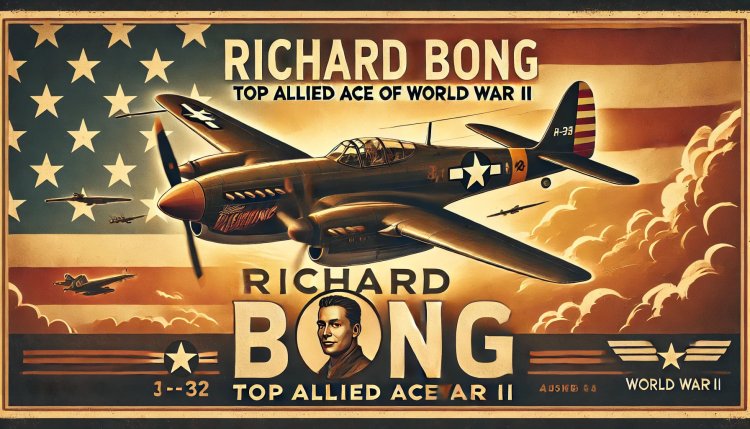Richard Bong: Top Allied Ace of World War II
Richard Ira Bong, America's 'Ace of Aces' during World War II, was a legendary P-38 Lightning pilot with 40 confirmed aerial victories. Born in 1920 in Wisconsin, Bong's exceptional flying skills earned him the Medal of Honor. His daring combat style and precision in air battles made him the most decorated American fighter pilot of the war. Tragically, he lost his life in a test flight accident in 1945 while piloting the Lockheed P-80 Shooting Star. His legacy remains an inspiration in military aviation history.

Richard Ira "Dick" Bong (September 24, 1920 – August 6, 1945) was a United States Army Air Forces major and Medal of Honor recipient in World War II. He was one of the most decorated American fighter pilots and the country's top flying ace in the war, credited with shooting down 40 Japanese aircraft, all with the Lockheed P-38 Lightning. He died in California while testing a Lockheed P-80 jet fighter shortly before the war ended. Bong was posthumously inducted into the National Aviation Hall of Fame in 1986 and has several commemorative monuments named in his honor around the world, including an airport, two bridges, a theater, a veterans historical center, a recreation area, a neighborhood terrace, and several avenues and streets, including the street leading to the National Museum of the United States Air Force in Dayton, Ohio.
- wikipedia Little Women
Richard Ira Bong who was destined to became America’s ‘Ace of Aces’ of World War 2 was born in 1920, the son of a Swedish immigrant father and Anglo-Scots mother. His early years were spent on the family farm at Poplar Wisconsin. In essence he was the typical American youngster, working on the family farm and gaining high grades at school. He was also a keen sportsman, playing on the school’s baseball, basketball and hockey teams. Fishing and hunting were abiding interests for the teenager at which he became proficient with a hunting rifle. Like many of his contemporaries Bong developed an early interest in aviation and during his secondary education at Superior State Teachers College in 1938 he enrolled in the civilian pilot training program and also took flying lessons. In early 1941 with America yet uncommitted to the European conflict Bong enlisted in the Army Air Corps aviation cadet program.
Training
Bong’s primary training was conducted at Rankin Aeronautical Academy in California in June 1941, followed by basic training at Gardner Field, California. From there he was sent to Luke Field Arizona for advanced training in single-engine (fighter) aircraft. His machine was the rugged AT-6 Texan (or Harvard in RAF service) which launched the bulk of trainee Allied pilots on their chosen career. Bong proved to be a natural pilot, obviously suited to fly fighters and in January 1942, just after Pearl Harbour he gained his Army Air Corps commission and those coveted pilot’s wings. But instead of an anticipated career as a fighter pilot Bong was retained as a gunnery instructor.
Operational
This tenure lasted several months when his opportunity for action was presented by the introduction of the Lockheed P38 into Air Corps service. Bong quickly adapted to the challenge of the somewhat-intimidating twin-engine Lockheed, however his low-flying escapades around San Francisco bay soon attracted the attention of General George Kenney, head of the Fifth Air Force. No doubt the budding ace would have incurred the general’s wrath for his undisciplined aerobatics but significantly Bong was one of the pilots selected to join the 9th Fighter Squadron. He was shipped to Australia pending the delivery of the unit’s P38s, meantime Bong spent time with the 35th Fighter Group operating out of Port Moresby New Guinea. During his tenure with the 35th he opened his account with the destruction of two Japanese fighters, a Zero and an Oscar.
What’s in a Name
During the Pacific conflict Japan produced no fewer than 118 different types of military aircraft and in an effort to simplify identification American Air Intelligence allotted a distinctive name to each type. In early 1942 all enemy fighters were called Zero or Mitsubishi if they had more than one engine. However this was a dangerous over-simplification when evaluating the potential strength of one’s enemy. Eventually each aircraft was given an arbitrary title; with fighters and floatplanes receiving male Christian names; e.g. Zeke, Oscar, Rufe etc.; with bombers and flying boats given female Christian names; e.g. Betty, Sally, Mavis etc. It proved to be an efficient arrangement and from it there emerged a host of classic types, many of which proved equal in fame to the best of the Allied opposition.
An Ace Indeed
Meantime during 1943 Bong’s score was steadily rising, with each month proving successful. Mostly these were individual figures except on 26 July when he claimed four fighters while on bomber escort over Lae in northern New Guinea. By December 1943 Bong’s tally had reached 21, at which point he was sent on home leave to Wisconsin. During this welcome break from operational flying he met Marge Vattendahl, a young woman whose name and portrait would be featured on Bong’s P38 and whom he would marry in February 1945.
Ace of Aces
In February 1944 Bong returned to the New Guinea theatre where he resumed operations, this time in the ‘free-lance’ role, a situation that suited his individualistic nature. By April 1944 he had surpassed Eddie Rickenbacker’s WW1 record of 26, thus making Bong the current top-scoring American of two world wars. At this point General Kenney promoted Bong major and for a second time he returned home to The States where during May-July he made a series of publicity tours. These were not to Bong’s liking and in September he was re-assigned to the Southwest Pacific area as an advanced gunnery instructor at Hollandia. General Kenney did allow Bong to go on missions but not to seek combat and merely defend himself whenever necessary. Nevertheless by early October he added three more to his victory tally and with the American landings in the Philippines Bong successfully lobbied to be included in this crucial action. By mid-December 1944 Bong increased his score to forty and at that point he was finally grounded by General Kenney and sent home. Prior to that Bong was presented with the Congressional Medal of Honor by General MacArthur on Tacloban airfield.
A New Career
By New Year’s Eve the ‘Ace of Aces’ was back in The States where he was sent on a PR tour to stimulate public interest in purchasing war bonds. That duty completed, in February 1945 he married Marge and after a Californian honeymoon he began training as a test pilot at Wright Field in the development of the new Lockheed P80 Shooting Star. This involved a two-month theory course on jet propulsion before getting the chance to fly one. Finally Bong was checked out on the P80 and during that summer flew it on eleven occasions. August 6 1945 is a date indelibly remembered as the day on which the first atomic bomb was detonated over Hiroshima. It is also significant as the occasion of Richard Bong’s final flight. After defying the odds on 200 combat missions over 500 combat hours he became a victim of the law of averages when his P80 suffered a flame-out on take-off. Bong made an emergency bail-out but with insufficient altitude he perished in the attempt. It was a sad conclusion to a brilliant aviation career and especially tragic to be betrayed by mechanical failure. During Bong’s operational career he described combat flying as great fun and not being overly concerned with victory scores but rather the zest of actual combat. This attitude differed greatly from other aces whose sole concern was their scores, almost to the point of recklessness. Bong on the other hand felt no shame in abandoning combat when the situation was unfavourable. His closest rival on the closing stages of a remarkable operational career was another P38 exponent, the great Tommy McGuire with 38 scalps to his credit and the acknowledged Pacific ace following Bong’s departure.
A Challenging Mission
McGuire however was not destined to overtake Bong’s tally of 40 when he too became a victim of the law of averages. On 7 January 1945 he led a flight of experienced P38 pilots, Rittmayer, Thropp and Weaver on an early morning fighter sweep over the Japanese airfield at Negros Island. However inclement weather forced them to proceed to another airfield on the western side of the airfield. Abruptly a lone KI-43 Oscar flew through the group, passing below McGuire and his wingman before either pilot could react. Meanwhile a KI-84 Frank joined the melee and inflicted damage on Thropp’s P38; while Rittmayer who had earlier experienced engine trouble managed to frighten the Frank off Thropp’s tail. Rather than retreat the Japanese pilot chose to stay and harass the P38s, firing bursts into Weaver’s aircraft.
Ironic Destiny
At that point Weaver summoned McGuire’s assistance; whose response was immediate but as he banked steeply to his left his Lightning shuddered, lost momentum and was last seen inverted and nose down, followed seconds later by an explosion. Tommy McGuire had fallen and the aggressive pilot of the Frank inflicted further loss to the Americans when Major Rittmayer was brought down near the area where McGuire had crashed a few minutes earlier. The surviving P38s, both suffering damage managed to escape the situation and return to base. It had been a tragic outcome, particularly so for McGuire being denied the opportunity to overtake Bong’s tally and ironic that the award he so coveted, The Medal of Honor would be awarded posthumously.
Credit reference: Wings Magazine Vol.2 1988
What's Your Reaction?




















